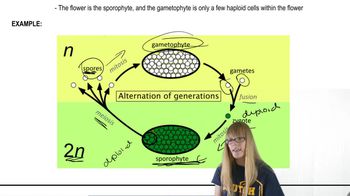The human genome contains 2.9×10⁹ base pairs. Approximately how many nucleosomes are required to organize the 10-nm–fiber structure of the human genome? Show the calculation you use to determine the answer.
Table of contents
- 1. Introduction to Genetics51m
- 2. Mendel's Laws of Inheritance3h 37m
- 3. Extensions to Mendelian Inheritance2h 41m
- 4. Genetic Mapping and Linkage2h 28m
- 5. Genetics of Bacteria and Viruses1h 21m
- 6. Chromosomal Variation1h 48m
- 7. DNA and Chromosome Structure56m
- 8. DNA Replication1h 10m
- 9. Mitosis and Meiosis1h 34m
- 10. Transcription1h 0m
- 11. Translation58m
- 12. Gene Regulation in Prokaryotes1h 19m
- 13. Gene Regulation in Eukaryotes44m
- 14. Genetic Control of Development44m
- 15. Genomes and Genomics1h 50m
- 16. Transposable Elements47m
- 17. Mutation, Repair, and Recombination1h 6m
- 18. Molecular Genetic Tools19m
- 19. Cancer Genetics29m
- 20. Quantitative Genetics1h 26m
- 21. Population Genetics50m
- 22. Evolutionary Genetics29m
7. DNA and Chromosome Structure
Eukaryotic Chromosome Structure
Problem 3a
Textbook Question
In eukaryotic DNA, where are you most likely to find histone protein H4?
 Verified step by step guidance
Verified step by step guidance1
Understand that histone proteins, including H4, are part of the nucleosome structure in eukaryotic DNA. Nucleosomes are the basic units of chromatin, which help in DNA packaging.
Recall that a nucleosome consists of DNA wrapped around a core of histone proteins. This core is made up of two copies each of histones H2A, H2B, H3, and H4.
Recognize that histone H4 is one of the core histones and is located in the nucleosome core, where it interacts with DNA and other histones to stabilize the structure.
Note that histone H4 is specifically involved in forming the histone octamer and plays a role in the tight wrapping of DNA around the nucleosome.
Conclude that histone H4 is most likely to be found in the nucleosome core, tightly associated with DNA in eukaryotic chromatin.
 Verified video answer for a similar problem:
Verified video answer for a similar problem:This video solution was recommended by our tutors as helpful for the problem above
Video duration:
2mPlay a video:
Was this helpful?
Key Concepts
Here are the essential concepts you must grasp in order to answer the question correctly.
Eukaryotic DNA Structure
Eukaryotic DNA is organized into a complex structure known as chromatin, which consists of DNA wrapped around histone proteins. This organization allows for efficient packaging of DNA within the nucleus and plays a crucial role in gene regulation and expression.
Recommended video:
Guided course

DNA Structure
Histone Proteins
Histone proteins are a family of basic proteins that help package and order DNA into structural units called nucleosomes. Each nucleosome consists of a segment of DNA wound around a core of histone proteins, including H4, which is essential for maintaining the structural integrity of chromatin.
Recommended video:
Guided course

Proteins
Nucleosome Formation
Nucleosomes are the fundamental units of chromatin, formed by the wrapping of DNA around a histone octamer, which includes two copies of H2A, H2B, H3, and H4. This formation is critical for DNA compaction and regulation, as it influences access to genetic information during processes like transcription and replication.
Recommended video:
Guided course

Formation of Plant Gametes
Related Videos
Related Practice
Textbook Question
395
views


